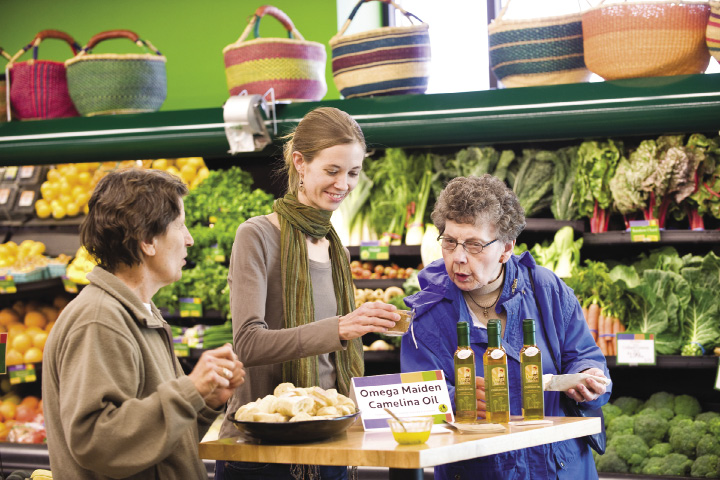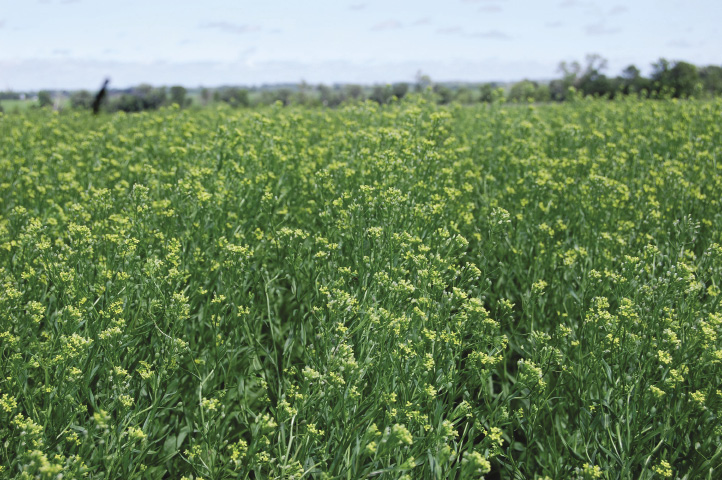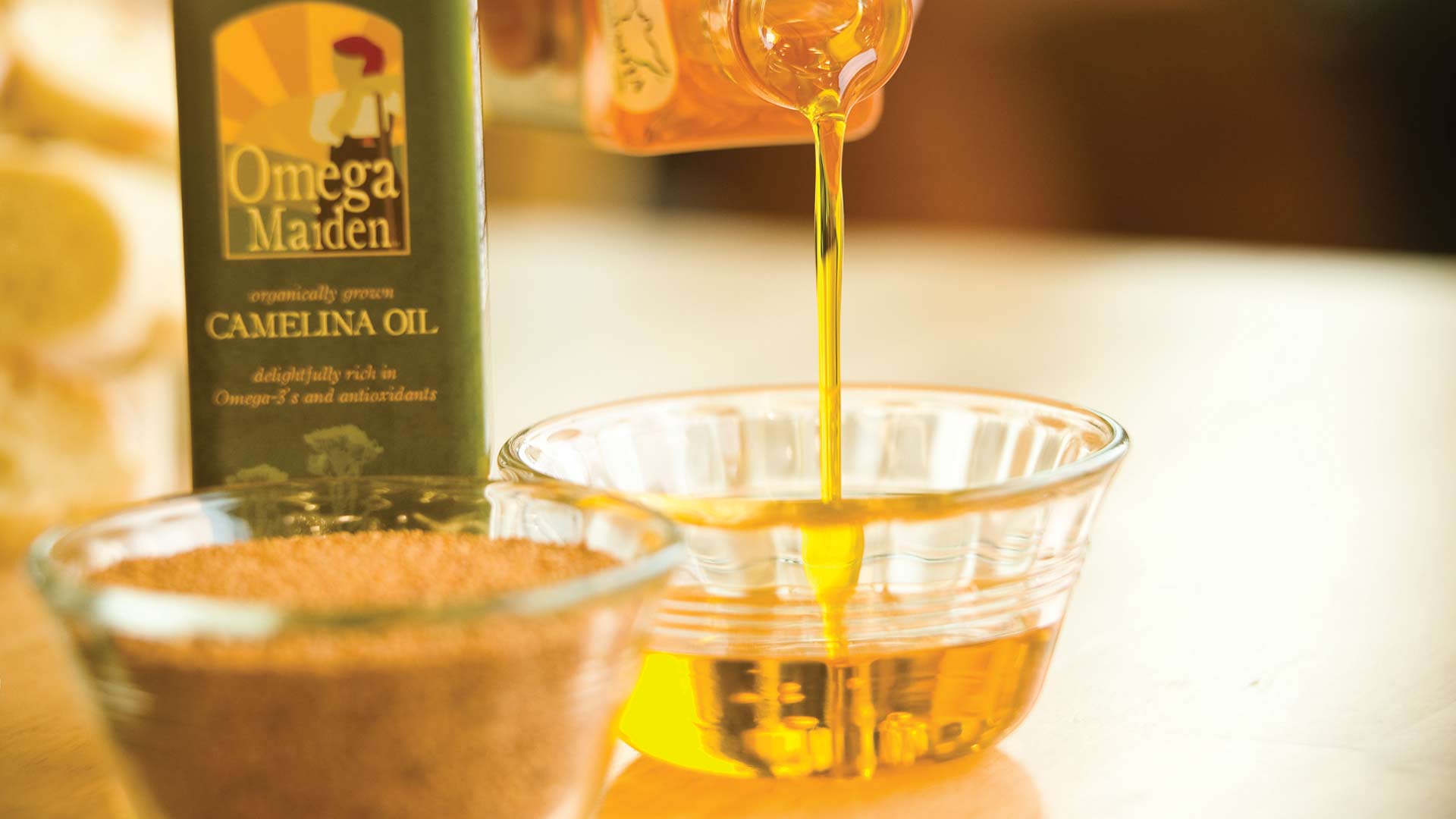Lamberton, Minn. — After working on agricultural development in West Africa, Kathleen Batalden Smith and her husband Justin Smith came home to rural Minnesota and began some ag development of their own.

Kathleen and her family are growing and bottling organic camelina oil for the health food market. Camelina is a traditional oilseed related to flax. Its golden-colored oil is a good source of heart-healthy, omega-3 fatty acids and Vitamin E.
The new venture, called Omega Maiden, is a partnership between Kathleen and her dad, Phil Batalden. A fourth-generation farmer, Phil raises the camelina on the family’s certified organic crop and livestock farm in southwest Minnesota. Kathleen handles oil production and marketing. The company started bottling Omega Maiden camelina oil late last year and is now setting up wholesale and retail distribution.
Returning to rural Minnesota
Omega Maiden grew out of Kathleen’s strong ties to the Batalden family farm, where she grew up.
“I’ve always felt very deeply rooted to the farm. My father, as he transitioned to organic production, developed a passion for sustainable farming and good stewardship, and he passed that on to us. It’s something we learned as we grew up.”
After college and graduate school, Kathleen and her husband served in the Peace Corps. They spent two years working in a farming village in Niger, an impoverished country in West Africa, where the principal crops are millet and sorghum. The couple taught villagers about natural resources, soil testing, erosion control and crop improvement.
These defining experiences in Africa cemented the couple’s desire to live simply in a rural area, Kathleen says. “After living in a small, strongly-knit community in West Africa, we wanted the same for our new home in the U.S.”
The Smiths returned to Minnesota in 2010, settling near Kathleen’s family in Lamberton. She and Justin share an entrepreneurial outlook, Kathleen says, and wanted to be self-employed. Justin, a professional woodworker, launched a new business, Smiling Tree Toys, a line of fine, hand-crafted wooden toys.
Kathleen wanted to become more involved in her family’s farming operation. Buying more land wasn’t feasible, she says, so “we’ve been exploring how to do more with the farm’s existing resources. We were also looking for something that had the potential to be a value-added product.”
Phil Batalden “has always been very forward thinking,” his daughter says, “very progressive.” He was interested in new crops to add to his rotation, to aid in weed and pest control. At an organic growers conference, he heard about a hardy, short-season oilseed crop, camelina, which requires few inputs, smothers weeds and can be produced with conventional equipment. He said to his daughter, “If I grow it, can you sell it?” Kathleen was intrigued, so “we dove in head first.”
Never heard of camelina?
Camelina, sometimes called false flax or wild flax, is a cool-season oilseed that was widely grown in Eastern Europe until about the 1940s, when it was supplanted by canola. It produces small yellow flowers and tiny seeds that contain 30 to 40 percent vegetable oil, says Russ Gesch, a scientist at the USDA Agricultural Research Service in Morris, Minn., who is working on camelina production improvements.
Today, camelina is being raised commercially in Montana, primarily to make biodiesel. Camelina oil can also be used to make jet aircraft fuel and bio-lubricants.
In addition, camelina oil contains about 35 percent linolenic acid, one of the omega-3 fatty acids, which lower inflammation and contribute to good health. More familiar sources of omega-3 fatty acids are flaxseed oil and fish oil. Camelina supplies almost as much omega-3 as flaxseed, as well as natural antioxidants, including Vitamin E. And camelina oil doesn’t deteriorate during storage, like flaxseed oil or fish oil, Kathleen says. Her family likes its mild, nutty taste on salads, roasted vegetables and home-baked bread.
Pressing ahead
The Bataldens planted 3.5 acres of camelina in 2010 and 8 acres in 2011. The crops produced about 1,000 pounds of seed per acre, or 38 gallons per acre of cold-pressed organic oil. The leftover portion of the seed makes a high-protein livestock feed.
The Bataldens contract with a Wisconsin organic producer to extract the oil in a mechanical press, and Kathleen does the bottling by hand. A small grant from the USDA’s Sustainable Agriculture Research and Education program paid for start-up costs. AURI food scientist Charan Wadhawan helped analyze nutritional information for the product label. The oil is produced in a state-inspected facility.
Connecting with consumers
Omega Maiden oil is packaged in a high-end glass bottle with a cork stopper and retails as a nutritional supplement at $16 for 8.5 ounces. The upscale look is designed to position Omega Maiden as a premium product, Kathleen says.
The specialty oil is aimed at health-conscious consumers who want local, sustainably-grown farm products, she says. “We’re working to revive chemical-free, sustainable agriculture that strengthens rural economies and piques people’s interest in traditional foods.”
The company’s first target market is Minnesota food co-ops. “Consumer awareness is our biggest obstacle,” Kathleen says. “Camelina is not well known,” and Omega Maiden is one of just a handful of U.S. companies selling it as a retail product.
The Omega Maiden branding effort is designed to highlight the oil’s nutritional value, as well as the story of the Batalden family farm, Kathleen says. “We felt that our name should indicate why a consumer would be interested in this product.” The label pictures “a strong rural woman,” and the company’s website, omegamaidenoils.com, gives consumers a way to connect directly with the farm and family.
“We value the quality of life” in farm country, says Kathleen, 31, and “the connections a rural community offers.” She and Justin hope other young adults will think about starting businesses and raising families in rural Minnesota, as they are doing. “We hope a rural revival is on its way.”
About Camelina

The plant: Annual oilseed in the mustard family; grows 25 to 30 inches tall; yellow flowers; pale green leaves and seed pods; very tiny seeds contain 30-40 percent oil, 25 percent protein.
Agronomic traits: Short season crop, 85-100 days; can grow on arid or marginal land; low water and fertilizer needs; cold and drought tolerant; good stands are weed resistant; no major pests; may be susceptible to downy mildew and white mold.
Production: Conventional equipment; can be planted in late fall, winter or early spring, broadcast or drilled; straight combine, or swath and dry in windrows.
Yields: 670 to 2,240 pounds of seed per acre.
Uses: Biodiesel fuel, edible and industrial oil, cosmetics, livestock feed. n
Source: Russ Gesch, USDA-ARS, and Institute for Agriculture and Trade Policy
Minnesota organic farmer experiments with new oilseed crop
Camelina is a hardy oilseed that could potentially produce more oil than soybeans or canola with less fertilizer, pesticides or water.
Phil Batalden, a certified organic crop and livestock producer from Lamberton, Minn., has grown camelina on a small scale for two years.
He was looking for additional low-input crops to add to his corn-soybean-small grains rotation when he heard a local extension educator talk about camelina. “He mentioned that the meal makes a high-protein livestock feed, and the oil is quite valuable.”
Batalden got some advice about growing camelina from Montana-based Great Northern Growers Cooperative, which produces camelina for oil, feed and fuel. He decided to try the new crop after his daughter agreed to market the oil.
In 2010, a learning year, Batalden planted about 3.5 acres of camelina with a grass seeder pulled by a four-wheeler. “We harvested a crop, but it was seeded too thick,” he says.
In 2011, to prepare a better seedbed for the tiny seeds, Batalden made one spring pass with a field cultivator, then packed the ground. He used a grain drill with a grass seed attachment to plant 8 acres of camelina on April 12. Then he packed the field again.
He got a pretty good stand, although some parts of the field were washed out by last spring’s heavy rains. Camelina followed soybeans, so nitrogen was adequate, and “we had very good in-season weed suppression.”
Camelina seed pods don’t all ripen at the same time. On July 18, when about 80 percent of the seed capsules were ripe, he swathed the field, allowed the crop to dry in windrows for several days, then threshed the crop with the combine. Yield was about 1,000 pounds of seed per acre.
Ripe camelina seed pods — round capsules about the size of a marble — tend to break in half during combining, spilling seed, Batalden notes. He was worried about unwanted volunteer plants coming up the following spring, but “we haven’t had any problems with volunteers.”
The short-season crop leaves enough time after harvest to establish a fall green manure cover crop, such as hairy vetch.
Camelina is quite a bit less expensive to grow than wheat, Batalden says. “I think it has good potential.”
He hasn’t decided yet how much to plant in 2012. “It depends on how much oil we sell.”
A guide to omega-3 claims
Omega-3 fatty acids are popular with health-savvy consumers. But for a food processor, it’s confusing to know what omega-3 claims can be made on a food label. To help, AURI has developed a claims guide, which provides general information about fatty acids and requirements for health claims. The guide is available on AURI’s web site: auri.org.

